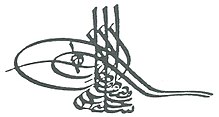Selim III
However, Austria and Russia gave him no time for anything but defense, and it was not until the Peace of Iaşi (1792) that breathing space was allowed him in Europe, while Napoleon's invasion of Egypt and Syria soon called for the empire's most vigorous efforts.
Selim III profited by the respite to abolish the military tenure of fiefs; he introduced salutary reforms into the administration, especially in the fiscal department, sought by well-considered plans to extend the spread of education, and engaged foreign officers as instructors, by whom a small corps of new troops called Nizam-I Cedid were collected and drilled in 1797.
[5] These troops were able to hold their own against rebellious Janissaries in the Balkan provinces such as the Sanjak of Smederevo against its appointed Vizier Hadži Mustafa Pasha, where disaffected governors made no scruple of attempting to make use of them against the reforming sultan.
Emboldened by this success, Selim III issued an order that in the future, picked men should be taken annually from the Janissaries to serve in the Nizam-I Cedid.
[citation needed] Selim III was unable to integrate the Nizam-I Cedid with the rest of the army which overall limited its role in defense of the state.
[5] Selim III ascended the throne only to find that the Ottoman Empire of old had been considerably reduced due to conflicts outside the realm.
Although distressed by the establishment of the republic in France, the Ottoman government was soothed by French representatives in Constantinople who maintained the goodwill of various influential personages.
For decades, a sultan's word had had no power in outlying provinces, prompting Selim's reforms of the military to reimpose central control.
One rebellious leader was Austrian-backed Osman Pazvantoğlu, whose invasion of Wallachia in 1801 inspired Russian intervention, resulting in greater autonomy for the Danubian provinces.
The Sultan's most ambitious military project was the creation of an entirely new infantry corps fully trained and equipped according to the latest European standards.
This unit called the Nizam-I Cedid (the new order), was formed in 1797 and adopted a pattern of recruitment that was uncommon for the imperial forces; it was composed of Turkish peasant youths from Anatolia, a clear indication that the devshirme system was no longer functional.
But Selim III's inability to integrate the force with the regular army and his reluctance to deploy it against his domestic opponents limited its role in defending the state it was created to preserve.
From the start of Selim's reign, the Janissaries had viewed this entire military reform program as a threat to their independence, and they refused to serve alongside the new army in the field.
Led by the rebellious Janissaries, these forces came together in 1806, deposed Selim III, and selected a successor, Mustafa IV, who pledged not to interfere with their privileges.
Over the next year, the embassies in Europe were dismantled, the Nizam-I Cedid troops were dispersed, and the deposed sultan, whose cautious military reforms were intended to do no more than preserve the tradition of the Ottomans, was murdered.
The first major Russo-Turkish War (1768–1774) began after Turkey demanded that Russia's ruler, Catherine II the Great, abstain from interfering in Poland's internal affairs.
They captured Azov, the Crimea, and Bessarabia, and under Field Marshal Pyotr Rumyantsev, they overran Moldavia and also defeated the Turks in Bulgaria.
In an attempt to support and open a route to link up with Tipu Sultan, Napoleon invaded Ottoman Egypt in the year 1798, causing a furor in Constantinople.
Despite Selim III's hardline stance on alcohol consumption and threats to execute Christians and Jews caught selling wine or rakı to Muslims, it proved extremely difficult to curtail alcohol consumption in Istanbul, where wines were locally produced, and the city had many established wine-houses serving its non-Muslim residents.
[12] The 1806 Edirne Incident was an armed confrontation between the New Order Troops (Nizam-I Cedid) of Ottoman Sultan Selim III and a coalition of Balkan magnates, the ayans, and the region's Janissary garrisons that occurred in Thrace throughout the summer of 1806.
[13] Selim III was, however, thoroughly under the influence of French ambassador to the Porte Horace Sébastiani, and the fleet was compelled to retire without effecting its purpose.
The ayan of Rustchuk, Alemdar Mustafa, a strong partisan of the reforms, collected an army of 40,000 men and marched on Constantinople to reinstate Selim III, but he came too late.
[14][unreliable source] Upon his arrival in the capital, Bairakdar's only resource was to wreak his vengeance on Mustafa IV and to place on the throne Mahmud II (1808–1839), the sole surviving member of the House of Osman.
The assassins were a group of men, including the Master of the Wardrobe, Fettah the Georgian, the Treasury steward Ebe Selim, and a black eunuch named Nezir Ağa.
Sixty-four compositions by Selim III are known today, some of which are part of the regular repertory of Turkish classical music performance.
As a patron of the arts, Selim III encouraged musicians of his day, including Dede Efendi and Baba Hamparsum.






